—Learn about and view examples of this exciting gunite pool feature

Rim flow spas—also called mirror spas, full-perimeter spas, and 360-degree overflow spas—represent a dramatic style of elevated custom spa with specially configured exposed tile- or stone-covered walls that allow the water inside to sleekly run over the spa’s entire perimeter into the swimming pool below.
Some also produce a kind of “vanishing” effect where the cascading spa water looks almost like it is disappearing into the pool deck.
This captivating spa concept is rapidly becoming a favorite design option with homeowners building inground pools who seek a standout backyard attraction.
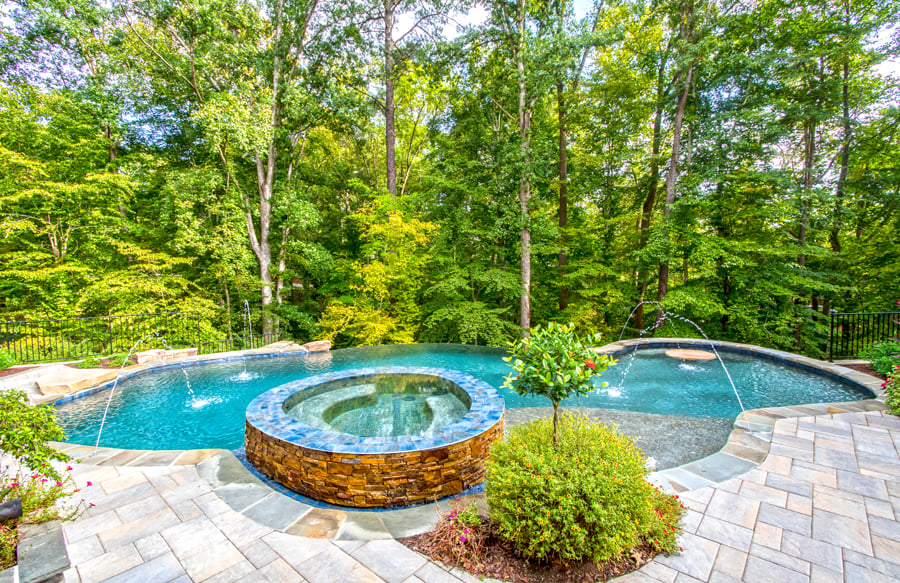
Versatility: Rim flow spas are often incorporated into poolscapes with a modern aesthetic. But this awe-inspiring feature can also successfully punctuate a natural lagoon- or rustic-style pool.
Spa configuration: The basics
Two clever design elements distinguish rim flow construction from that of a traditional gunite spa: One is the absence of a sectional, delineated spillway for the exiting spa water.
The second is how the spa’s wall tops are built completely “open” and serve double duty as both a dam wall (to separate the spa and pool) and as a single expansive spillway (that lets the water escape).
Many rim flow spas also boast the special “vanishing water” effect mentioned above—something a conventional custom spa cannot give you.
Before explaining these unique design characteristics, it’s helpful to understand some fundamental aspects of regular spa design and construction.
Dam walls and spillways
To begin with, the portion of a spa that’s shared with the pool is known as the dam wall. Whether traditional or rim flow, every spa connected to a swimming pool has a dam wall.
Just like the action of a municipal dam on a reservoir, this wall holds back the spa water. It is built with one or several spillways.
A spillway is an open section near the top of the dam wall; it’s a kind of channel or “pass through” over which spa water can travel into the pool below. (Water circulates out of the spa when the pump is running to circulate water for filtration and sanitation.)

Regular spillway: With a traditional elevated spa, water comes out through a kind of slot called a spillway—a slightly lower section of dam wall.
A wide array of lovely spa dam wall and spillway styles are possible. The spillway can be either exposed to show off the tile or “hidden” by covering it with coping (material such as brick, poured concrete, or natural stone) or deck material.
Next, let’s consider the tops of the walls in a regular raised spa. Contractors cover 50 to 100 percent of the tops with either coping or with the same material as the surrounding pool deck.


Covering Up: In traditional spa construction, flagstone and concrete are common examples of decorative finishes used to top off the walls.
Rim flow design differences
Whereas water is channeled through a single or several spillways in one portion of a regular spa’s dam wall, the water inside a rim flow spa circulates out over 100% of the top perimeter.
With a rim flow structure, the entire wall is built at a uniform height that is at least as high as a traditional spa spillway. That’s because the full-length top of the rim flow wall is the spillway.
No coping material caps off any portion of dam wall. Instead, its tiled top surface is left totally exposed in all of its shimmering, colorful glory.

Fully falling: The rim flow spa’s tiled top walls serve as one large, continuous spillway with water flowing out into the adjacent pool.
Water cascading over the full length of the spa perimeter makes for an impressive sight. In some rim flow projects, water will slide over part of the spa’s perimeter onto the pool surface in an open matter—you can see the water hitting the pool surface.
For example, say the spa is square and is set at a corner of the pool. The two spa sides facing the pool will be fully exposed, giving you a clear line of sight to the spa water moving down into the pool. (With a round spa, the same hold trues for roughly one third to one half of the circular wall.)
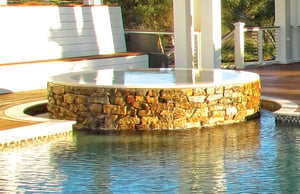
Watching the water: On the portion of the round spa wall that faces the pool, you can enjoy an unobstructed view of the water as it rolls down the spa’s face into the pool surface.
Disappearing act
Another effect that’s possible only with a rim flow spa relates to the route that some of the overflowing water travels.
This travel path comes into play if the spa is located in a traditional position at one edge or corner of the pool. This configuration will yield an intriguing outcome: the illusion that much of the spa water is falling into the deck.
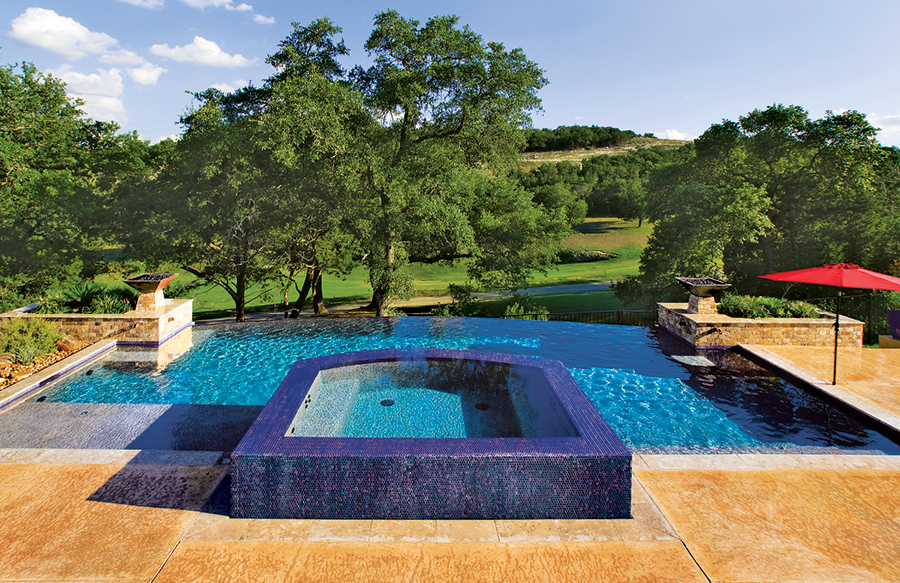
Where did it go? As it slides down the spa’s deck-adjacent exterior side, the water nearly looks like it’s mysteriously disappearing right into the concrete hardscape.
Returning to the example of a square rim flow spa, let’s take a look at its construction to understand what’s really happening.
Two sides of the rim flow spa are surrounded by and built almost flush with the deck. Separating the spa walls from the edge of the deck is a trough—a kind of narrow catch basin.
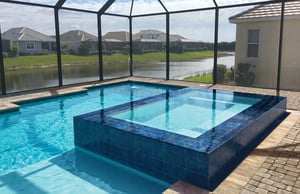
Four-sided Spills: Here, spa water exits in all directions. On two sides, you can watch it directly enter the pool. From the other two, the water first drops into a narrow trough that carries it back into the pool.
Typically, this trough is only several inches deep. Pool builders finish it with either tile or plaster for waterproofing and appearance.
The trough is crucial to a rim flow spa placement at the edge or corner of a pool. The reason why: It catches the outgoing spa water and channels it back into the pool.
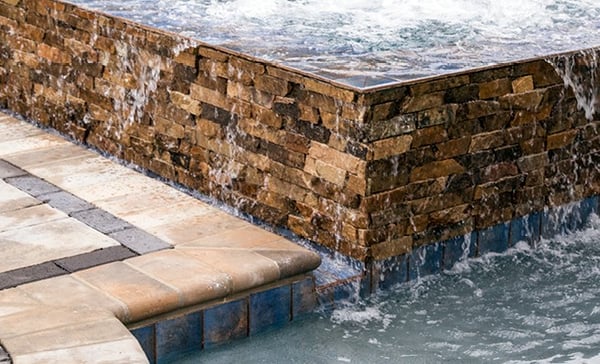
Secret Passage: Between the spa wall and the deck, you can see how the exiting water falls into a narrow trough that empties into the pool.
Builders configure these troughs around the exterior of the spa walls, and they use dimensions that suit the particular project design and building materials. The spa size and water capacity also impact how wide the trough needs to be.
In general, the trough width—the expanse from the deck’s edge to the spa wall—ranges from four to nine inches.
Now, here is where a design trick makes the “magic” happen. When builders install the deck, they cantilever it.
That means roughly one inch of deck’s perimeter coping extends out over the pool water. And on a rim flow spa, this material extends one to several inches out over the trough—usually covering most of the trough’s actual width.
As a result, most of the trough’s width is blocked from view. Only a narrow portion is visible—usually about one to three inches. Overflowing spa water is actually being accommodated in a larger area than you see.

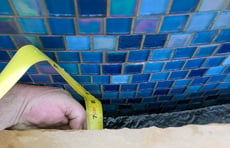
Reality vs. the “Reveal”: The area between the deck and this rim flow spa looks like only a thin slot. However, the flagstone coping installed over this particularly wide trough prevents you from seeing much of its true width.
Spa location options
For additional visual appeal, your builder can position a rim flow spa within the swimming pool in several visually entertaining ways.
First, the spa can be built entirely within the pool’s interior. As a result, the spa will be surrounded by pool water—typically with at least several inches of H2O in all directions.
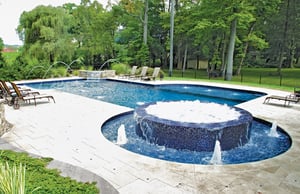
Circular statement: In this compelling poolscape, a trio of bubbler fountains accent the 360-degree sphere of overflowing spa water.
One benefit of this spa placement is visibility: From nearly anywhere around the pool or patio, you can enjoy viewing the spa’s decorative tile or stone finish and its water falling gently onto the pool surface.
In certain poolscapes, positioning the rim-flow spa at least several feet away from the closest pool wall provides another design treat: This location creates a quasi “island effect”—the spa almost looks like it’s floating inside the pool.
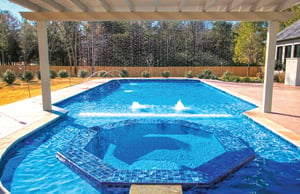 Surrounded hexagon: This entire, geometric rim flow spa sits within the pool’s interior in a specially built shallow section. With this kind of arrangement, the spa walls are just a few inches higher than the water outside them.
Surrounded hexagon: This entire, geometric rim flow spa sits within the pool’s interior in a specially built shallow section. With this kind of arrangement, the spa walls are just a few inches higher than the water outside them.
Lastly, a rim flow spa can be built entirely away from the pool—or even without a pool. In a small backyard or simply because you want a warm bubbling spa and no pool, you can have a stylish, stand-alone inground spa.
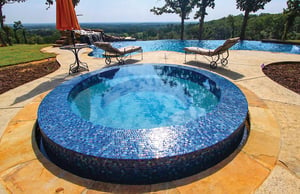
Spectacular solo: Like a traditional gunite spa, a rim flow design can be built on its own—detached from the swimming pool.
Note: Keep in mind that that construction costs make a custom free-standing spa nearly as much as a complete pool. But some homeowners want only a spa. Of these, some want an attractive one—versus settling for a bulky prefabricated hot tub that sits on the ground.
Mirror mirror: The fairest spa of all
Another stunning look that a rim flow spa can deliver is reflection.
How does that happen? When the pump is turned off, the spa water no longer exits the structure and remains still.
This motionless surface transforms into a virtual liquid mirror, reflecting the sunlight, trees, the sky, and other backyard objects. To maximize the potential for this reflective quality, choose spa tile in a dark color.
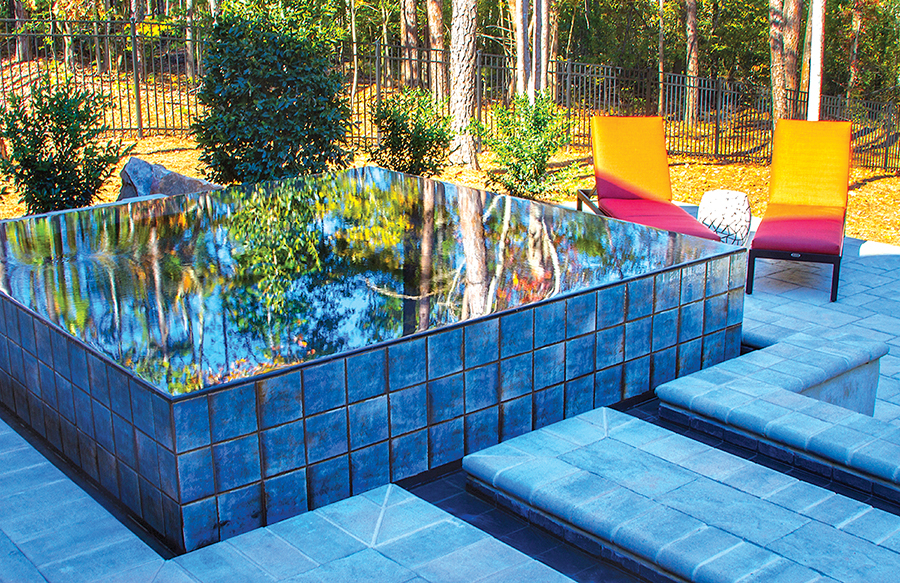
Aqua-flections: See the image of sky, nearby trees, or architectural elements of your home captured by the surface of your rim flow spa.
Finishing options
As with a regular custom spa, you can cover a rim flow spa’s exterior sides with either tile or stone.
Using tile on the walls is the most common approach for rim flow construction, particularly if you desire a modern style aesthetic.
However, you can achieve an organic look for a tropical or rustic setting by using stone on the spa’s exterior.
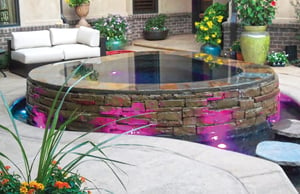
Stonewalling: By choosing a soft free-form shape for the structure and natural stone for the exterior, this rim flow spa blends well into a natural, relaxed backyard setting.
For both the sides and tops of the spa walls—aka the full-perimeter spillway—you have a wide variety of pool tile options in porcelain, stone, and glass. All can produce handsome good looks.
However, for a luxe look, glass tile is the way to go. The upgrade material is a superb choice to generate maximum impact. With all of the exposed tile, surfaces on the spa, the glass sparkles under the water and in the sunlight for a spectacular sight.
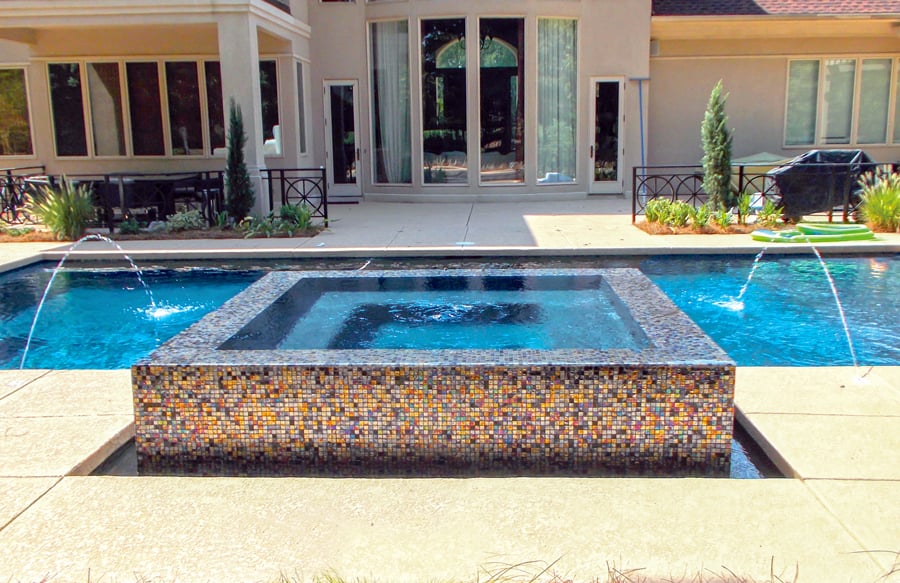
Dazzling dam walls: Luminous glass tile on this contemporary rim flow creation gleams in the sunlight for eye-catching enjoyment.
Like its porcelain and stone cousins, glass tile comes in a variety of colors, shapes, and patterns. You can also select from several kinds of finishes that are flat, reflective, or iridescent.

Monochromatic wonder: With all sides and tops of the spa exposed for viewing, the glass tile in glistening shades of blue produces a sophisticated feature.
Striking simplicity
Rim flow spas are increasingly popular for good reason: This modern, custom-designed structure provides a wonderful focal point in any gunite pool’s silhouette.
If you are building a custom pool and plan on including a spa for the lifestyle benefits it offers, don’t miss the opportunity to max out the potential for its good looks as well. This distinctive backyard amenity takes the wow factor to the next level.




.jpg?width=1490&name=rock-waterfall-slide-pool%20(1).jpg)